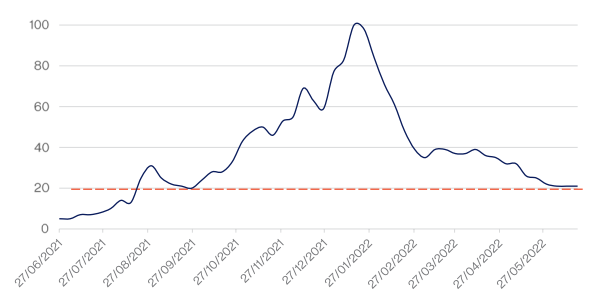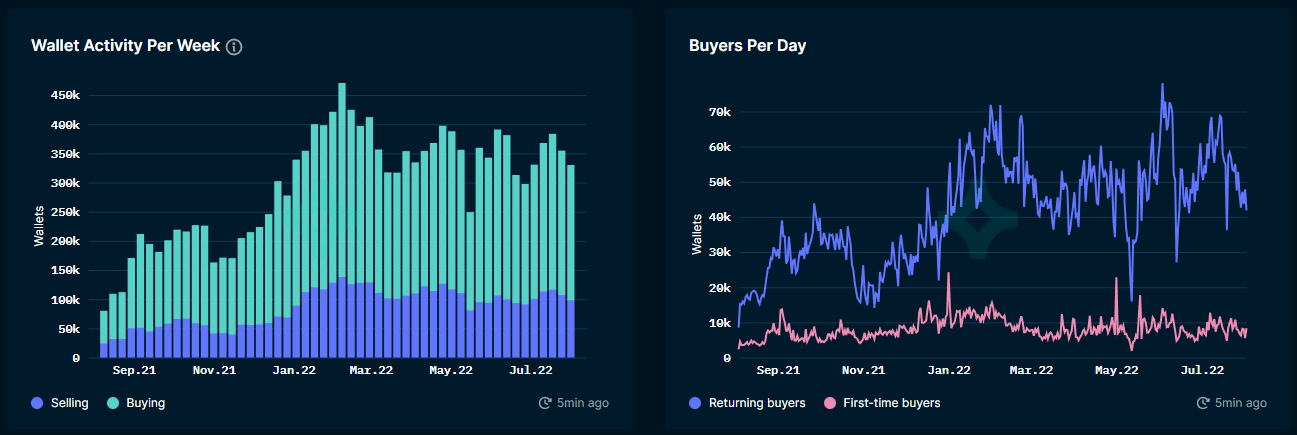While the entire crypto market is experiencing a historic bear market, the last quarter has also dramatically changed the NFT market. Liquidity is down and dollar prices are highly influenced by the decline in the value of cryptocurrencies. However, this masks a long-term trend.
Those who entered the NFT market a few months ago with the expectation of buying and reselling at a profit will most likely be disappointed. A year into the industry's boom, many promises seem either delayed or non-existent. The world has not yet shifted to the metaverse, our digital IDs are not NFTs, and most importantly, not all NFT holders became millionaires - the disappointment seems large. But as so often happens in financial markets, ebb follows flood, and the joy of NFTs brought millions of new users into the blockchain ecosystem.
NFTs have not disappeared, only the spotlight
The volume of internet searches on the topic of NFT has declined significantly since the peak in January 2022. However, the figures should be taken with a pinch of salt. It can be seen that interest has fallen back to the level of September 2021. At that time, it was the "Golden Age" for the whole area around NFTs. The Metaversum and utilities segments have both actually seen a sharp increase in their activity in terms their number of sales and dollar volume traded. This may seem paradoxical in a bear market context.

This can be explained by the sale of OtherDeed for OtherSide (Yuga Labs' metaverse) on the one hand and the sudden enthusiasm for four-digit domain names on Ethereum Name Service on the other. Apart from these two segments, which are performing surprisingly well in this market context, almost all indicators are declining. Countries in Southeast Asia continue to show the most interest. It is interesting to note that some Middle Eastern and African countries are starting to appear in the top 20: Lebanon, Nigeria and the United Arab Emirates. In Europe, only the Netherlands and Switzerland are on the list of NonFungible's quarterly report.
Meanwhile, games and collectibles account for 2/3 of the total market, which continues to be a leader in the number of sales and the size of communities. From an income statement perspective, the art segment is seeing more resales for the first time, with about $5 million in losses last quarter. The collectibles segment, which saw the biggest decline (-16%), is still profitable overall with a profit of $265 million. Given the trend in recent weeks, it is reasonable to expect this rate to increase and reverse in the next quarter. The average holding period fell to less than 30 days for the two strongest segments in the last quarter.
Ethereum gains momentum once again
The primary beneficial user of NFT adoption is the Ethereum smart contract platform. The blockchain network supports a wide range of applications enabled by "smart contracts". As a result, Ethereum favors decentralized autonomous organizations (DAOs), diverse applications (dApps), decentralized financial applications (DeFi), and non-fungible tokens (NFTs), as well as the open metaverse. In reality, NFTs are the only application besides Memecoins that have made it into the mainstream, yet.

Around 10,000 new users enter the Ethereum ecosystem every day to trade NFTs; with an average of 300,000 daily active addresses across the dApp landscape, this is an impressive number. This is supported by other metrics that identify NFTs as the primary driver of crypto adoption over the past year. Obviously, this is the case: collectible images are much more deeply embedded in our pop culture than financial apps, which are perceived as boring and off-putting to the majority of people.
"We believe there are a few key drivers of [Ethereum's] growth. The first has to do with appealing to a digital-native generation. NFTs bridge many gaps between the traditional and new worlds - the physical and digital, the consumer and crypto worlds. Everyone finds pleasure in collectibles in the niche that interests them." - Charles d'Haussy, Managing Director ConsenSys; the company behind leading Ethereum wallet MetaMask
Unbeaten NFT trading volume
More than 6 million Ethereum addresses hold at least one NFT. There are about 77,000 NFT collections and 111,000 NFT smart contracts, but only some of them are actively traded. The NFT blue-chips (BAYC, CryptoPunks, etc.) are living up to their name and have been able to almost maintain their floor price in Ether (ETH), in addition to currency losses. With around 40 million daily trading volume, Ethereum remains the clear market leader for NFTs.

Besides Ethereum, competitor Solana and scaling solution Polygon have also been able to amass a significant NFT community. Some well-known Solana NFTs such as DeGods, Solana Monkey Business, OkayBears, and Founders Coin can boast daily trading volumes in the low millions. In the low-cost blockchain, there are currently about 47,000 NFT collections and a total of nearly 21 million non-fungible tokens residing on over 2.2 million wallets.

Mass-market NFTs seem to be finding their foothold on the Ethereum sidechain Polygon. With nearly 17 million wallet addresses, over half a billion low-cost transfers have already been executed. The 236,000 NFT smart contracts generated more than 168 million different digital assets, with volumes of a meager $500,000 per day testifying to rather low-cost exhibits.









